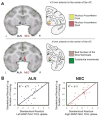Brain regions associated with the expression and contextual regulation of anxiety in primates
- PMID: 16043132
- PMCID: PMC2614874
- DOI: 10.1016/j.biopsych.2005.05.021
Brain regions associated with the expression and contextual regulation of anxiety in primates
Abstract
Background: A key to successful adaptation is the ability to regulate emotional responses in relation to changing environmental demands or contexts.
Methods: High-resolution PET 18fluoro-deoxyglucose (FDG) scanning in rhesus monkeys was performed during two contexts (alone, and human intruder with no eye contact) during which the duration of anxiety related freezing behavior was assessed. Correlations between individual differences in freezing duration and brain activity were performed for each of the two conditions, as well as for the contextual regulation between the two conditions.
Results: In both conditions, activity in the basal forebrain, including the bed nucleus of the stria terminalis and the nucleus accumbens were correlated with individual differences in freezing duration. In contrast, individual differences in the ability to regulate freezing behavior between contexts were correlated with activity in the dorsal anterior cingulate cortex, the thalamus and the dorsal raphe nucleus.
Conclusions: These findings demonstrate differences in the neural circuitry mediating the expression compared to the contextual regulation of freezing behavior. These findings are relevant since altered regulatory processes may underlie anxiety disorders.
Figures




Similar articles
-
Orbitofrontal cortex lesions alter anxiety-related activity in the primate bed nucleus of stria terminalis.J Neurosci. 2010 May 19;30(20):7023-7. doi: 10.1523/JNEUROSCI.5952-09.2010. J Neurosci. 2010. PMID: 20484644 Free PMC article.
-
Electrolytic lesions of the bed nucleus of the stria terminalis disrupt freezing and startle potentiation in a conditioned context.Behav Brain Res. 2011 Sep 23;222(2):357-62. doi: 10.1016/j.bbr.2011.03.066. Epub 2011 Apr 7. Behav Brain Res. 2011. PMID: 21497171
-
Amygdalar and hippocampal substrates of anxious temperament differ in their heritability.Nature. 2010 Aug 12;466(7308):864-8. doi: 10.1038/nature09282. Nature. 2010. PMID: 20703306 Free PMC article.
-
Neural mechanisms of freezing and passive aversive behaviors.J Comp Neurol. 2005 Dec 5;493(1):111-4. doi: 10.1002/cne.20734. J Comp Neurol. 2005. PMID: 16254996 Review.
-
Sensory pathways and emotional context for action in primate prefrontal cortex.Biol Psychiatry. 2011 Jun 15;69(12):1133-9. doi: 10.1016/j.biopsych.2010.08.008. Epub 2010 Oct 2. Biol Psychiatry. 2011. PMID: 20889144 Review.
Cited by
-
Behavioral inhibition: a neurobiological perspective.Curr Psychiatry Rep. 2006 Aug;8(4):270-8. doi: 10.1007/s11920-006-0062-7. Curr Psychiatry Rep. 2006. PMID: 16879790 Review.
-
The Relationship Between the Uncinate Fasciculus and Anxious Temperament Is Evolutionarily Conserved and Sexually Dimorphic.Biol Psychiatry. 2019 Dec 15;86(12):890-898. doi: 10.1016/j.biopsych.2019.07.022. Epub 2019 Jul 31. Biol Psychiatry. 2019. PMID: 31542153 Free PMC article.
-
The Effects of Prior Stress on Anxiety-Like Responding to Intra-BNST Pituitary Adenylate Cyclase Activating Polypeptide in Male and Female Rats.Neuropsychopharmacology. 2017 Jul;42(8):1679-1687. doi: 10.1038/npp.2017.16. Epub 2017 Jan 20. Neuropsychopharmacology. 2017. PMID: 28106040 Free PMC article.
-
The distribution of D2/D3 receptor binding in the adolescent rhesus monkey using small animal PET imaging.Neuroimage. 2009 Feb 15;44(4):1334-44. doi: 10.1016/j.neuroimage.2008.10.020. Epub 2008 Oct 29. Neuroimage. 2009. PMID: 19015034 Free PMC article.
-
The neurobiology of dispositional negativity and attentional biases to threat: Implications for understanding anxiety disorders in adults and youth.J Exp Psychopathol. 2016;7(3):311-342. doi: 10.5127/jep.054015. J Exp Psychopathol. 2016. PMID: 27917284 Free PMC article.
References
-
- Alkire MT, Haier RJ, Shah NK, Anderson CT. Positron emission tomography study of regional cerebral metabolism in humans during isoflurane anesthesia. Anesthesiology. 1997;86(3):549–557. - PubMed
-
- Amaral DG, Price JL, Pitkanen A, Carmichael ST. Anatomical organization of the primate amygdaloid complex. In: Aggleton J, editor. The Amygdala. New York: Wiley-Liss; 1992. pp. 1–67.
-
- Biederman J, Hirshfeld-Becker DR, Rosenbaum JF, Herot C, Friedman D, Snidman N, et al. Further evidence of association between behavioral inhibition and social anxiety in children. Am J Psychiatry. 2001;158:1673–1679. - PubMed
-
- Breiter HC, Etcoff NL, Whalen PJ, Kennedy WA, Rauch SL, Buckner RL, et al. Response and habituation of the human amygdala during visual processing of facial expression. Neuron. 1996;17:875–887. - PubMed
Publication types
MeSH terms
Substances
Grants and funding
LinkOut - more resources
Full Text Sources
Medical

